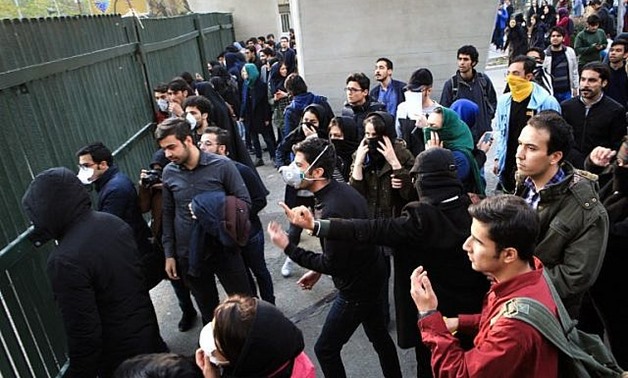
Iranian students protest at the University of Tehran during a demonstration driven by anger over economic problems in the capital, Tehran, December 30, 2017/ AFP/STR
CAIRO – 9 January 2018: Despite the success of the Iranian regime to overcome many protest waves in the past, recent protests suggest a new level of socio-political and economic despair among Iranians. Iranians’ loss of faith in the regime has pushed them over the edge, leading some to protest uncontrollably, and others to commit suicide and self-immolation. These developments occurring in the Iranian conservative society suggest a turning point within the Persian state’s political and social development trajectories.
After 11 days of protests against the Iranian regime since December 28, an Iranian young man committed suicide in prison after being arrested by security forces during an anti-regime protest in northern Tehran. Another Iranian vendor set himself on fire to showcase his despair and loss of confidence in the Iranian Government.
A few days after being arrested, the 22-year-old young man decided to end his misery and committed suicide while being held at Evin jail, in the Evin neighborhood of Tehran, according to the ILNA news agency. Evin prison was built during the era of Mohammad Reza Pahlavi in 1972. It has built a reputation for being Iran's political prison.
“I obtained information from the security forces and Intelligence Ministry confirming the suicide of the detained protester,” Iranian Parliamentarian Tayebeh Siavashi told ILNA.
According to the Facebook account “Iran News Update,” an Iranian protester committed self-immolation in protest of the Iranian regime led by Supreme Leader Ali Khameni.
The opposition account posted a video showing the self-immolation incident, commenting, “An Iranian set himself on fire on Sunday.”
Since the eruption of protests in Iran on December 28, the Iranian security forces arrested more than 1,700 persons and 22 protesters have been killed in clashes with the police, according to official Iranian news reports.
Protests started with chanted complaining from high food prices, unemployment and economic stagnation, but quickly evolved into expressions of anger against Iran's clerical leadership, including President Hassan Rouhani, who had promised to revive the economy.
Police used tear gas and water cannons to disperse the protests in Tehran, chanting slogans to bring down the theocracy. This is the most significant unrest in Iran in nearly a decade.
NCRI issued a statement on Friday revealing that the Iranian regime has blocked social networks in Iran since the first days of "the uprising,” cutting off the internet completely in some areas and implementing severe restrictions on it in others.
In May 2015, dozens of protests against the deterioration of living conditions were organized in Ahwaz. Groups sought to link protests against the Iranian regime's practices, such as the Iranian intervention in the affairs of Arab countries including Iraq, Syria and Yemen.
Barack Obama's Administration and several western governments expected the nuclear deal would lead to a change in Iran's “behavior” and policies at home and abroad. There was an assumption that the interests and pragmatism of the Iranian regime would automatically force it to develop the country's economic structure and improve living standards first.
Iranians, especially youth, approved and praised the nuclear deal put forth in 2015, which meant canceling the sanctions, in hopes of improving economic conditions and providing job opportunities. However, it soon became obvious that the wager of western countries on the improvement of Iran's regional behavior was not different from the wager of Iranians on Iran's improvement of its domestic behavior, as neither was achieved.
Iranians had high hopes when President Hassan Rouhani, who is perceived to be moderate, took office. Despite his weak and limited internal reforms, he was re-elected for a second term. The first budget presented last month seemed to be a test. It showed his intention to consolidate his power and reach “accord” that ends the government's differences with the “Revolutionary Guard” and the religious institutions, directly connected with Supreme Leader Ali KhamenI, by increasing their allocated funds without having sufficient resources.
The protests represented a surprise for the regime assuming that the whole society is united behind it and proud of the regime's achievements. The world community ruled out these protests because it expected that the people will not remain silent and that there will be an internal uprising after the regime receives blows in its areas of influence abroad.
Perhaps it is most surprising that the protests started in the strongholds of Persian nationalism in the Iranian depth in Mashhad, Shiraz and Esfahan before reaching Tehran, and not in the provinces of Arabs, Kurds, and other ethnic groups who have chronic demands of their national rights.
Unlike the Green Movement protests in 2009, there is no known leadership for the ongoing protests but their logic is obvious. The protests do not have specified goals but their ambitions of change are obvious.
Looking from a different angle, there are various factors that make the fall of the Mullah Regime just a matter of time. The latest deep domestic divisions among the key figures of the regime, the continually deteriorating economic conditions, the social problems, such as confiscating private freedoms of the youths and women, the increase of corruption in state apparatuses and suppression of non-Persian Iranian minorities, all suggest that the Iranian regime is floating in a sea of problems; a sea that may drown it very soon.


Comments
Leave a Comment